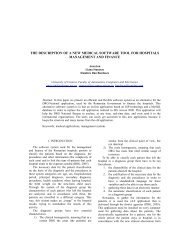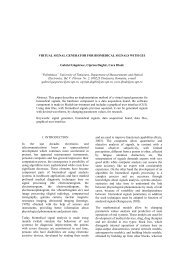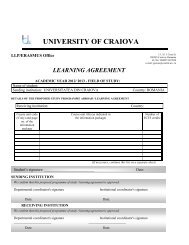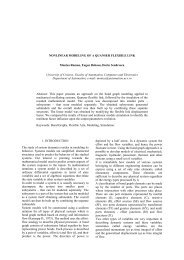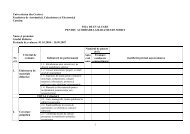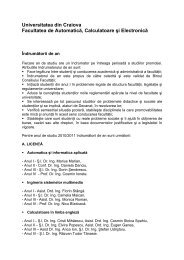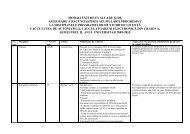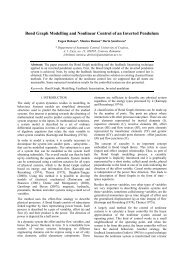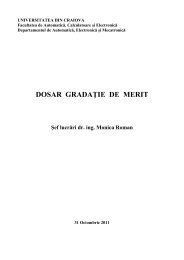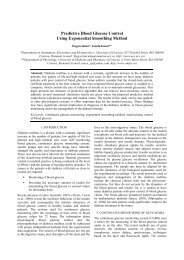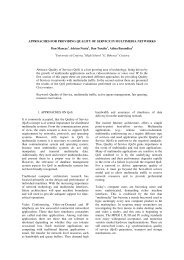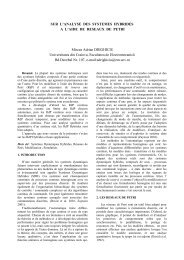Pilotage à distance de systèmes automatisés et robotisés ...
Pilotage à distance de systèmes automatisés et robotisés ...
Pilotage à distance de systèmes automatisés et robotisés ...
You also want an ePaper? Increase the reach of your titles
YUMPU automatically turns print PDFs into web optimized ePapers that Google loves.
La connexion a Intern<strong>et</strong> <strong>de</strong> ces <strong>systèmes</strong><br />
automatises <strong>de</strong> production imposera t elle ou non<br />
une modification profon<strong>de</strong> <strong>de</strong> leur informatique au<br />
niveau langage <strong>de</strong> programmation en particulier.<br />
On peut aussi souhaiter que dans un premier<br />
temps un effort <strong>de</strong> recherche <strong>et</strong> développement<br />
porte sur la génération automatique <strong>de</strong> tous les<br />
éléments perm<strong>et</strong>tant l’interfaçage avec <strong>de</strong>s<br />
utilisateurs distants. Pour finir on ne peut que<br />
souhaiter que <strong>de</strong>s progrès importants aient lieu<br />
dans les aspects multimédia qui facilitent la<br />
perception a <strong>distance</strong> <strong>de</strong> l’état global d’un SAP.<br />
La mise au point <strong>de</strong> <strong>systèmes</strong> automatiques qui<br />
allouent dynamiquement les flux multimédias en<br />
fonction <strong>de</strong>s impératifs lies <strong>à</strong> la tache <strong>à</strong> réaliser me<br />
semble nécessaire. Enfin la réalité virtuelle <strong>et</strong><br />
l’apport <strong>de</strong> la réalité augmentée sera sans nul<br />
doute un plus qui modifiera profondément le poste<br />
<strong>de</strong> pilotage distant du SAP futur.<br />
SAP ; Système <strong>de</strong> Production Automatisee<br />
6 - Références :<br />
[1] Serge Monchaud and Dimitar Draganov –<br />
Telemanufacturing Systems: a New Concept –<br />
IEEE INES’97 International Conference –<br />
Budapest Hungary – September 1997.<br />
[2] Ken Golberg, Steve Bui, Billy Chen, Bobak<br />
Farzin, Jacob Heitler, Derek Poon, Rory Salomon,<br />
and Gordon Smith – Collaborative teleoperation<br />
via the intern<strong>et</strong> – IEEE ICRA San Francisco CA<br />
USA April 2000 - The telegar<strong>de</strong>n –<br />
http://telegar<strong>de</strong>n.aec.at .<br />
[3] Patrick Saucy and Francesco Mondada –<br />
Khepontheweb: Open access to a mobile robot on<br />
the intern<strong>et</strong> - IEEE robotics and Automation<br />
Magazine - mars 2000.<br />
[4] Reid Simmons: Xavier: An autonomous<br />
mobile robot on the web - International Workshop<br />
on Intelligent Robots and Systems (IROS)<br />
Victoria, Canada, 1998.<br />
[5] Erwan Le Rest : Pilot : Un langage pour la<br />
Telerobotique. Thèse <strong>de</strong> doctorat Université <strong>de</strong><br />
Rennes 1 (F) : Juin 1996.<br />
[6] Pascal Ogor: Une architecture générique pour<br />
la supervision sure a <strong>distance</strong> <strong>de</strong> machine <strong>de</strong><br />
production avec Intern<strong>et</strong>. These <strong>de</strong> Doctorat<br />
Universite <strong>de</strong> Br<strong>et</strong>agne Occi<strong>de</strong>ntale (F):<br />
Decembre 2001.<br />
Remerciements :<br />
Je tiens a remercier tout particulièrement<br />
Monsieur Pascal Ogor pour son travail <strong>de</strong> thèse <strong>de</strong><br />
doctorat [6], effectue dans le cadre du PRIR<br />
Teleproductique (1998- ).<br />
Son apport méthodologique pour la spécification<br />
<strong>de</strong> <strong>systèmes</strong> surs pour la supervision a <strong>distance</strong> <strong>et</strong><br />
son apport dan le domaine <strong>de</strong>s logiciels dédies a<br />
ce type d’applications ont gran<strong>de</strong>ment inspires les<br />
quelques pistes que j’ai r<strong>et</strong>enues pour rédiger c<strong>et</strong>te<br />
contribution a SINTES 2003.<br />
-----------------------------------------------------------<br />
Remote piloting of automatised and robotized<br />
systems–general problems and some solutions-<br />
Abstract: The massive introduction of many<br />
applications linked to intern<strong>et</strong> and multimedia<br />
techniques during the last <strong>de</strong>ca<strong>de</strong> is associated to<br />
the globalisation of the world economy.<br />
They also have enhanced the remote using of<br />
industrial systems more or less complex.<br />
The remote applications were introduced long<br />
time ago in the applications domains where the<br />
human being was not permitted i.e. space<br />
applications, submarine using, nuclear actions <strong>et</strong>c<br />
or in cases of acci<strong>de</strong>nt and danger for human<br />
beings, without forg<strong>et</strong>ting the military<br />
applications like missiles, drones, <strong>et</strong>c.<br />
The technological knowledge acquisition is very<br />
important but with a very high cost incompatible<br />
with the normal civil domain and the secr<strong>et</strong><br />
character of the results.<br />
Our problematic is sli<strong>de</strong>ly different. In our case<br />
the remote piloting will integrate a common<br />
environment with normal human beings who stay<br />
the principal actor. The remote piloting tries to<br />
use human capacity and materials where they are<br />
located and it tries to suppress the displacements<br />
b<strong>et</strong>ween them. These displacements unusefull and<br />
cost effective are minimalised. In such way a<br />
more harmonious <strong>de</strong>velopment of the territory,<br />
with a big reduction of CO2 pollution connected<br />
to huge transportation will be favoured.<br />
The advantages are numerous but the<br />
disadvantages and difficulties are also increasing;<br />
First of all we must verify if the electronics links<br />
created by intern<strong>et</strong> are feasible enough than the<br />
physical and traditional ones. The exponential<br />
<strong>de</strong>velopment of intern<strong>et</strong> seems to give a positive<br />
answer. But the harmonious and equilibrated<br />
using of intern<strong>et</strong> is not warranty. The<br />
segmentation b<strong>et</strong>ween the different users will be<br />
contrary to the basic rules of intern<strong>et</strong> and will<br />
contradict its <strong>de</strong>velopment. Our approach is<br />
different - a free using of Intern<strong>et</strong> with acceptance<br />
of its weakness will be promoted.



